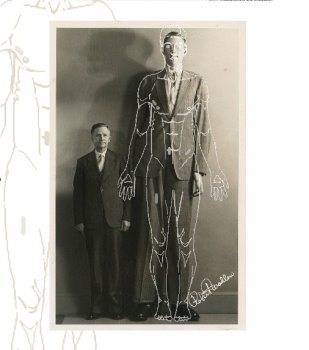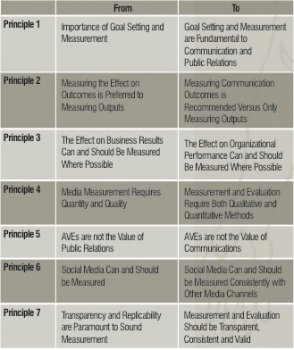
A FRAMEWORK FOR THE FUTURE
Public relations is undergoing a strategic shift which relies partly on the effective measurement and evaluation of communications. Brittany Golob reports from the launch of AMEC’s Barcelona Principles 2.0
 Barcelona brings to mind football successes, architectural beauty, seaside escapades and, in communications, the measurement and evaluation framework known as
Barcelona brings to mind football successes, architectural beauty, seaside escapades and, in communications, the measurement and evaluation framework known as
the Barcelona Principles. Established five years ago by a group of PR professionals who sought to provide guidelines surrounding the measurement and evaluation of PR after the International Association for the Measurement and Evaluation of Communication(AMEC) annual summit in Barcelona. The principles swiftly became well-known among the agencies who looked to them for guidance and to the in-house teams who asked for pitches referring to the framework and its relevance on their communications.
At the opening event of this year’s inaugural Measurement Month at Ketchum’s London offices, the Barcelona Principles 2.0 were unveiled. The updated framework reflects the changes made in the industry in the last five years and makes the principles relevant not just to PR specifically, but to all communicators.
“In the last five years there have been a number of evolutions in the field of public relations,” says immediate past chairman of AMEC and Ketchum partner David Rockland says. “The simplest one, the most important one, is the expansion of public relations into a broader field of communication... The principles are intended to relfect the relevance of communication to lots of different types of organisations and lots of different types of results.”
Rockland, was part of the team that set out the initial principles in 2010. He says the focus in Barcelona was the evaluation of specific pieces of coverage and the effect that had on sales. The biggest shift since then has been the shift in PR in general – from a nice to have to an integral, reputation-managing part of corporate communications.
In updating the principles themselves, the AMEC committee responsible for the task – convening in Stockholm during the annual AMEC International Summit – looked first at language. The 2010 version contained seven principles in stilted, unfinished phrasing. Rockland says the committee rewrote them to make them “Work in the language of English.” Looking at these sentences alone, there is little difference. Principle 2, “Measuring the effect on outcomes is preferred to measuring outputs,” has been translated to, “Measuring communication outcomes is recommended versus only measuring outputs.”
Yet, a subtle, important change has been consciously made. The words ‘public relations,’ which appear throughout the principles, have been replaced with ‘communications.’ This reflects the principles’ relevance to many areas of communications – from digital and social media to investor relations – and the ways in which PR is changing.
“We’ve reached an era where the best creative idea wins, no matter what type of agency it comes from. Then you execute it through your channels,” Rockland says. He points to a strategic shift in public relations. PR agencies are diversifying, as are their counterparts in marketing, digital and advertising. Thus, PR has become synonymous with reputation management and storytelling. Proving the value of those elements of communications to the board requires evaluation.
Jeremy Thompson, MD EMEA at Cision and AMEC chairman, says, “The dream outcome is that the PR industry and the communications industry adopts the best practice that we’ve developed and that together we grow and we put PR at the heart of the business agenda. And I think we are starting to do that. There are more PR heads in FTSE 100 boardrooms than there have ever been. People are recognising the value of reputation and we’re the custodians of it. We have to do a more professional job of promoting and defending reputation.”
Defra’s head of communications research and evaluation, Elayne Phillips, adds, “The refreshed Barcelona Principles reflect a more modern approach suited to the way communicators work in 2015. The biggest differences that stood out for me in Barcelona Principles 2.0 were firstly the recognition of the importance of learnings, particularly debunking the idea large quantitative metrics equal success; the push to balance qualitative and quantitative metrics, the plain English approach and the move from focusing on PR only towards broader communications.”
 Phillips is one of the government communicators that have embraced the Barcelona Principles and measurement as standard in all government communications. The UK government is lauded by Thompson and Rockland as it has been at the forefront of the move to evaluate communications. They both share the desire to see other governments follow suit.
Phillips is one of the government communicators that have embraced the Barcelona Principles and measurement as standard in all government communications. The UK government is lauded by Thompson and Rockland as it has been at the forefront of the move to evaluate communications. They both share the desire to see other governments follow suit.
The seven principles that make up the framework are just the beginning though. Supporting each principle is a description detailing the context for that principle and assisting communicators in enacting them. Principle 7 – which says, “Measurement and evaluation should be transparent, consistent and valid” – is complemented by the importance of measuring through both quantitative and qualitative methods. Numbers are important, but qualitative measurement allows the framework the flexibility to measure things like brand loyalty, trust and awareness. Essentially, the measurement of PR does not have to be linked to action in terms of sails or votes or donations. It is about reputation, recognition and brand development.
Throughout the principles are concepts that allow for more flexibility in the measurement and evaluation of communications. The Barcelona Principles were always adaptable across sector and type of organisation, but the Barcelona Principles 2.0 allows them to be flexible across type of communication. “I wouldn’t be surprised that in five years, if these get updated again, they wouldn’t be referring to public relations at all,” Rockland says. “They’re referring to how a mix of channels and of creative ideas drive an organisation’s results. How do you measure that’s taken place?”
Alongside the launch of the Barcelona Principles 2.0, AMEC is expanding its events calendar this year. Last year’s Measurement Week – a week of events in New York and London – was so popular that this September is Measurement Month. At the time of printing, over 50 events were scheduled in 25 countries. This is part of AMEC’s drive to educate communicators about the value and importance of measurement and evaluation. It will, Thompson says, “Hopefully achieve the ambition of raising awareness and promoting education of the principles and the frameworks that AMEC has developed to encourage best practice in the industry.” According to an AMEC poll, 95% of respondents said they want to understand how to do their jobs better. The education of existing communicators will eventually be complemented by collaborations with academics to encourage an earlier understanding of measurement and evaluation among communications students.
Barry Leggetter, CEO of AMEC, says, “The launch of Barcelona Principles 2.0 represents the first stage in a global education programme. AMEC is calling on all PR firms, PR associations, AMEC members and academics to get back this cross industry initiative and endorse the new principles. We have a new opportunity to make Barcelona Principles 2.0 internationally known – and used.”
This will have the added effect of showing communicators that measurement should be considered earlier in the process. At the outset of any campaign, clear goals should be set, Rockland says. From there, the measurement and evaluation of that programme will be easier to undertake, more relevant and yield more valuable results. “If you set goals well, you know how to do the measurement programmes,” Rockland adds. “Well-written goals give you the measurement answer.”
He appeals to in-house communicators to find out whom is the keeper of the numbers within their organisations. Market research, intelligence or insights already evaluated by the company will likely be usable by communicators as well. That makes for a more integrated comms and marketing function. “I would love to educate everyone from the chief exec down,” says Thompson. A lofty goal, but AMEC is well on its way to achieving widespread awareness and take-up of the Barcelona Principles. The updated framework will only pave the way for future advancement of the measurement and evaluation of communications.



